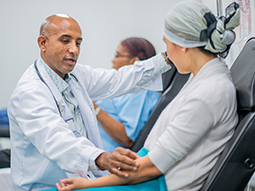Oropharyngeal cancers are malignant (cancerous) growths found in the oropharynx, the middle part of the throat that connects to the mouth and includes the tonsils. These cancers are highly treatable if caught early, because of their location.
Risk factors
No one knows why cells grow out of control and form oropharyngeal tumors. There are certain risk factors, though:
- Exposure to cigarette smoke
- History of smoking or alcohol abuse
Human papillomavirus (HPV), sex, and oropharyngeal cancer
Infections from some strains of the sexually transmitted human papillomavirus (HPV) can cause cancer on the tonsils (oropharyngeal cancer) or the back of the tongue (oral cancer). Please keep in mind that:
- There is no cure for HPV, but most people with infections from the particularly troublesome strains do not develop cancer.
- While the HPV vaccine cannot help patients already diagnosed with oropharyngeal or oral cancer, it can help prevent the diseases. Parents are encouraged to vaccinate their children at age 11 or 12, though men and women can get the shots as late as 26.
- Oropharyngeal and oral cancers are tested for HPV, and those that are positive often respond well to treatment.
- We are particularly knowledgeable about HPV-related head and neck cancers—one of our pathologists developed the vaccine and continues to research the diseases. This helps us appreciate the nuances of these cancers and the best treatment approaches.
Symptoms
Symptoms of oropharyngeal cancer may include:
- Lumps in the mouth or neck
- Trouble swallowing
- Change in voice
- Bleeding sores in the mouth
- Sore throat
- Bad breath
Other condition can also cause these symptoms, so it’s important to see a doctor right away. Keep in mind that oropharyngeal cancers caused by HPV infection are often harder to detect than tobacco-related cancers because the symptoms are often subtle and painless.
Diagnosis
To make a diagnosis, our doctors:
- Take a full medical history
- Perform a complete head and neck exam
- Possibly remove a small amount of the tumor during a biopsy, for further study
- Potentially run lab and imaging tests, including:
- X-ray
- MRI
- CT (CAT) scan
- PET scan
- Panendoscopy: direct laryngoscopy (look at voice box), esophagoscopy (esophagus), and bronchoscopy (bronchial tubes and lungs)
- Endoscopy: inserting a flexible tube called a scope with a light and camera down the nose and throat
These exams and tests help the doctor determine:
- The type of cancer and its stage
- How aggressive it is
- Whether it has spread
- How best to treat it
Cancer treatment
Treatment options for oropharyngeal cancer depend on:
- The cancer’s stage and grade
- The tumor’s location
- Preserving your ability to speak and swallow as much as possible
- Your overall health
Earlier-stage oropharyngeal cancer is treated with radiation or surgery—including the option of minimally invasive robot surgery for smaller tumors in the tonsils.
More advanced tumors are treated by giving radiation after surgery, or at the same time as chemotherapy. Sometimes all three treatments are used. We also have clinical trials looking at targeted therapies, when to use chemotherapy and which drugs to use, heating cancer cells and making the cells more sensitive to drugs or radiation.
Follow-up care
Patients who have had oropharyngeal cancer are at risk of developing a second head or neck cancer, and our doctors also want to catch any original cancer that might return. After treatment, they will ask you to come in for regular checkups, as frequently as once a month for the first year.
Our providers

Expert oncology care
Getting the care you need starts with seeing one of our oncologists.









